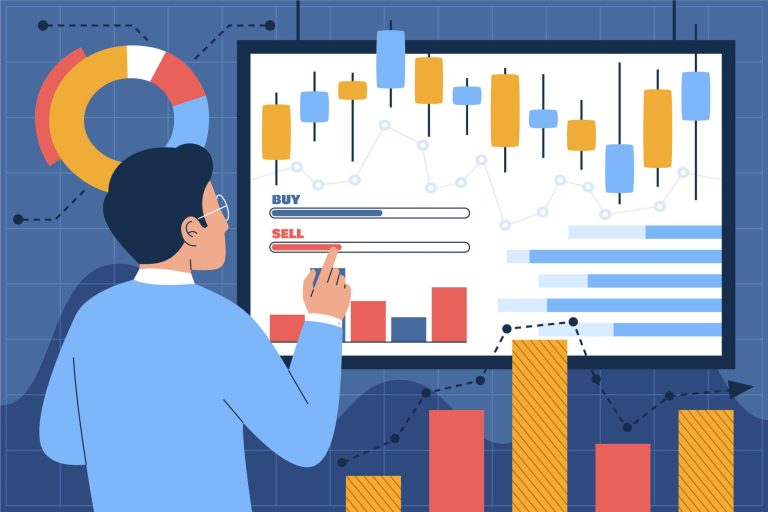How to Analyze the Forex Market: Technical vs. Fundamental Analysis
Successful forex traders must thoroughly understand market movements. They rely heavily on two primary methods: technical and fundamental analysis. Each approach offers unique insights and suits different strategies, risk tolerances, and trading styles. By gaining a clear understanding of their differences, strengths, and limitations, traders can make more informed decisions.

What is Technical Analysis?
Technical analysis uses historical price data, charts, and indicators to forecast future market movements. Traders examine patterns, trends, and price actions to identify entry and exit points. To achieve this, they use tools such as support and resistance levels, moving averages, and momentum indicators to assess market sentiment and stability.
Moreover, many incorporate chart patterns like head and shoulders, triangles, and flags to identify potential trend reversals or continuations. In addition, volume analysis helps confirm price movements and deepens their understanding of market dynamics.
Pros of Technical Analysis:
✔ Quick decision-making based on real-time data
✔ Useful for short-term and intraday trading strategies
✔ Identifies trends and market momentum
Cons of Technical Analysis:
✖ External economic and political factors are not considered
✖ False signals can be generated in volatile markets
✖ Requires constant monitoring and analysis
Furthermore, traders often rely on indicators such as the Relative Strength Index (RSI) and Bollinger Bands. These tools enhance their ability to spot price trends and interpret market psychology.
What is Fundamental Analysis?
Fundamental analysis evaluates economic, political, and financial factors that influence currency values. By analyzing data such as interest rates, inflation, employment figures, and geopolitical events, traders can anticipate market direction and potential price shifts. For instance, when central banks raise interest rates, it often attracts foreign capital and strengthens the currency. On the other hand, rising inflation can reduce purchasing power, leading to depreciation.
Additionally, to uncover meaningful trends, analysts review reports from government agencies and financial institutions. They also examine broader conditions—like global economic health, trade balances, and fiscal policies—that contribute to currency volatility. Ultimately, the goal is to build a well-rounded picture of market conditions and base decisions on economic fundamentals rather than short-term market noise.
Pros of Fundamental Analysis:
✔ Provides a long-term perspective on market trends
✔ Useful for predicting major economic shifts
✔ Helps in understanding the broader financial landscape
Cons of Fundamental Analysis:
✖ Short-term price movements may not always align with analysis
✖ Large amounts of data must be analyzed regularly
✖ Requires knowledge of economic indicators and global events
In practice, keeping track of economic calendars, central bank policies, and major news releases forms a core part of this method. By staying informed about these events, traders can make more strategic, long-term decisions.
Which Approach Should Be Used?
Many traders choose to blend technical and fundamental analysis to strengthen their trading strategies. While technical analysis highlights trade opportunities using patterns and indicators, fundamental analysis adds context by revealing the economic, political, and social forces behind market movements. Together, they provide a fuller, more informed market perspective.
As a result, this integration supports the development of balanced strategies that enhance decision-making and manage risk more effectively. For example, a trader might identify a buying opportunity using chart signals, then validate it by checking relevant economic indicators or news.
In many cases, using both methods also helps confirm trade ideas. When technical signals align with strong fundamentals such as favorable employment data or a policy shift, traders gain confidence in their positions. Conversely, if the signals conflict, they may reconsider or adjust their trades accordingly.
By combining insights from both disciplines, traders become better equipped to anticipate market reactions. Understanding how markets typically respond to specific economic events allows them to prepare for volatility and fine-tune their strategies in real time. Therefore, this dual approach empowers traders to adapt confidently to an ever-evolving market environment.
Learn More to Trade Smarter!

What is Lorem Ipsum?
Lorem Ipsum is simply dummy text of the printing and typesetting industry. Lorem Ipsum has been the industry’s standard dummy text ever since the 1500s,
How to Read Forex Charts Like a Pro
How to Read Forex Charts Like a Pro Forex charts are the foundation of every trader’s decision-making process. These charts visually display currency price movements

CFD Trading Explained: What It Is and How It Works
CFD Trading Explained: What It Is and How It Works Contracts for Difference, more commonly known as CFD Trading, represent a modern way of engaging
SmarTrade Featured in Manila Standard for Bringing Back Exclusive Trading Seminar to Manila
SmarTrade Featured in Manila Standard for Bringing Back Exclusive Trading Seminar to Manila SmarTrade has once again proven its leadership in financial education as it

Forex Broker: How to Choose the Right One
Choose the right Forex broker for your trading journey with essential tips and insights to enhance your trading experience and success.

Emotional Trading: How to Stay Calm and Collected
Discover the impact of emotional trading and learn strategies to maintain calmness and clarity in your trading decisions.
